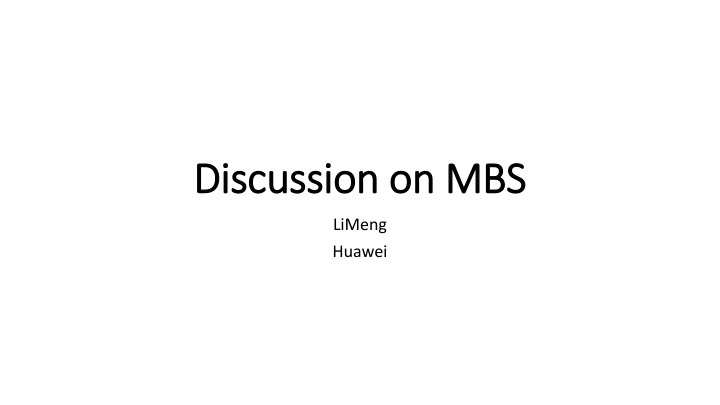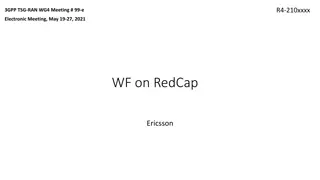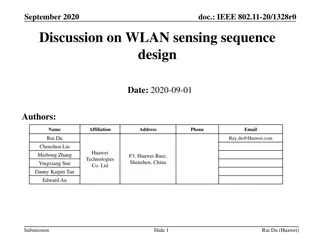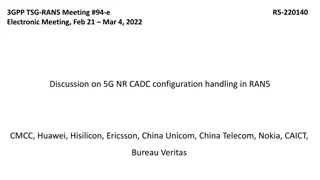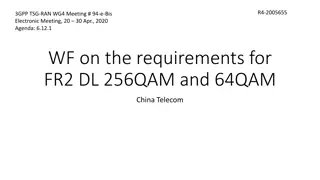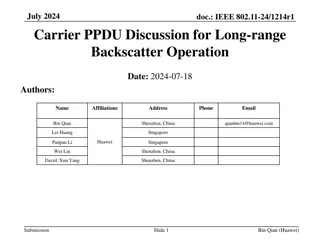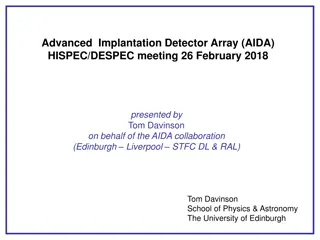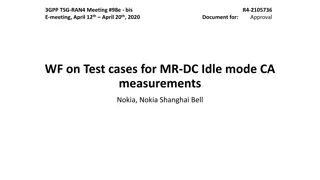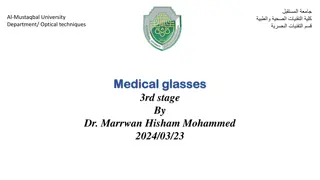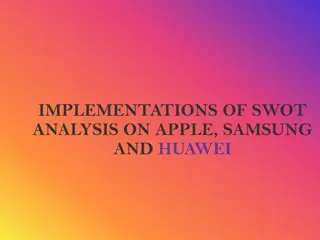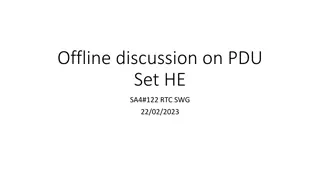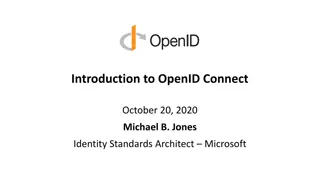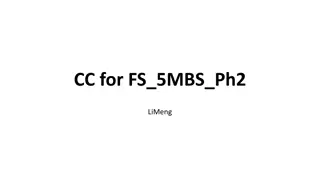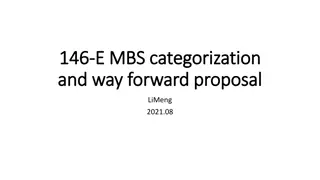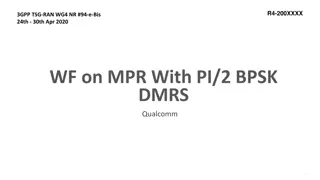Discussion on MBS with LiMeng Huawei
This content discusses various aspects related to MBS (Multimedia Broadcast Service) including open issues, proposals for Rel-18, and solutions for key issues. The agenda highlights topics like inactive reception, MOCN sharing, and identifying broadcast services in the 5G core network. It also delves into session activation, user services, and provides details on RRC Inactive reception with updates and solutions.
Uploaded on Apr 22, 2025 | 0 Views
Download Presentation

Please find below an Image/Link to download the presentation.
The content on the website is provided AS IS for your information and personal use only. It may not be sold, licensed, or shared on other websites without obtaining consent from the author.If you encounter any issues during the download, it is possible that the publisher has removed the file from their server.
You are allowed to download the files provided on this website for personal or commercial use, subject to the condition that they are used lawfully. All files are the property of their respective owners.
The content on the website is provided AS IS for your information and personal use only. It may not be sold, licensed, or shared on other websites without obtaining consent from the author.
E N D
Presentation Transcript
Discussion on MBS Discussion on MBS LiMeng Huawei
Agenda Agenda Merging proposals for Rel-18 (see other documents). Rel-18 open issues. KI#1: Inactive reception; KI#2: MOCN sharing; How to identify the broadcast service in 5GC. KI#3: on-demand MBS reception; Use case and/or benefits and solutions. Rel-17 open issues. MBS Session activation/deactivation MBS User service WID proposal. Click here to join the meeting
Rel Rel- -18 open issues 18 open issues
KI#1 (RRC Inactive reception) KI#1 (RRC Inactive reception) Overview 23.700-47: KI#1 and KI#6, Sol#26 Update to address ENs Nokia S2-2208288 23.700-47: KI#1, Sol#18: update to resolve ENs Ericsson S2-2208332 23.700-47: KI#1, Sol#27: update to resolve ENs 23.700-47: KI#1 Sol#20 update: resolving Editor's notes Ericsson CATT S2-2208333 S2-2208852 23.700-47: KI#1, update the solution 6 ZTE S2-2208963 23.700-47: KI#1, update the solution 28 ZTE S2-2208964 23.700-47: KI#1, Update to Evaluation and Interim Conclusion Ericsson S2-2208334 Evaluation: clarify solution #26, and #27; Conclusion: add one sentence saying AF provides preferable UE list in session creation procedure. on which UEs to keep in RRC_CONNECTED, clarify it can be cross-MBS sessions. And other clarifications. 23.700-47: KI#1, Interim conclusion updates Nokia S2-2208472 23.700-47: KI#1, evaluation updates Nokia S2-2208473 Add clarification for each solutions in a finer categories. (one small issue: 7.1.3 for solution #23 can be refined) Clarifying the way of using Mobility registration to join/leave, and other clarification. Clarification on the way of using assistant information. 23.700-47: KI#1 conclusions update CATT S2-2208853 23.700-47: KI#1, Further evaluation and conclusion update Huawei S2-2208904 23.700-47: KI#1, update the evaluation of Key issue#1 ZTE S2-2208961 Adding solution #27 and #28 to the table in clause 7.1. 23.700-47: KI#1, update the conclusion of Key issue#1 ZTE S2-2208962 Clarify that the CM-IDLE UEs can also make use of Service request to activate the associated PDU session and receive MBS data.
KI#1 (RRC Inactive reception), contd KI#1 (RRC Inactive reception), cont d Issue #1 the way to provide the assistant info for MBS MB- SMF UE RAN SMF PCF NEF AF UDM MBS session priority information 1a. MBS session creation (MBS session priority) 2a. Shared tunnel establishment (MBS session priority) MBS UE priority information 1b. Npcf_PolicyAuthorization_Update (Connected UE) 2b. PDU session modification (Connected UE) 3b. RAN MAY keep this UE to connected Alt#1 1c. MBS session creation (list of Connected UE) 2c. UE join 3c. Context subscribe (list of Connected UE) 4c. PDU session modification (Connected UE) Alt#2 1d. Authorized UE list + prioritized info 2d. PDU session establishment (SMF gets prioritized info) 3d. UE join 4d. PDU session modification (Inactive UE) Alt#3 Overview of Assistance information provisioning
KI#1 (RRC Inactive reception), contd KI#1 (RRC Inactive reception), cont d Issue #2 What information will be provided to the RAN? Alt #1: For an MBS session, an indication if the UE is Privileged(or the UE is suggested to be kept in CM-CONNECTED mode); Alt #2: For an MBS session, an indication if the UE can be switched to RRC Inactive mode and receive MBS data.? Alt #3: An indication if the UE is privileged (or suggested to be kept in CM-CONNECTED) Issue #3 How to include KI#1 in the WID objective? Proposal: add KI#1 in the WID objective from the perspective of requirement , e.g.,: Support of UEs within an MBS multicast session to receive MBS session data while in CM- CONNECTED with RRC Inactive state.
KI#2 (MOCN sharing) KI#2 (MOCN sharing) Overview Issue #1 Usage of TMGI and Backward compatibility? Issue #2 Resource efficiency? Issue #3 Flexibility of releasing? Issue #4 O&M Configuration to be standardized? Issue #5 Service layer enhancement? S2-2208395 23.700-47: KI#2, Evaluation Update Ericsson S2-2208474 23.700-47: KI#2, Interim conclusion updates Nokia S2-2208725 23.700-47: KI#2: Update the conclusions Huawei S2-2208732 23.700-47: Conclusion update on KI #2(MOCN network sharing) SAMSUNG S2-2208844 23.700-47: Conclusions for KI#2 Qualcomm ZTE S2-2208967 23.700-47: KI#2, update the evaluation and conclusion for the Key issue#2
KI#2 (MOCN sharing), contd KI#2 (MOCN sharing), cont d Issue #3 Flexibility of releasing/update? Issue #1 Usage of TMGI and Backward compatibility? Whether the release/update will affect other MBS sessions? Message sent for Rel-18 MOCN Rel-17 NG-RAN E.g., when release one MBS session, will other MBS session for the same broadcast service needs to be updated? Will the TMGI be re- allocated? Possibility to reject? Message sent for Rel-18 MOCN Rel-17 5GC NFs Possibility to reject? Issue #4 O&M Configuration to be standardized? Issue #2 Resource efficiency? Do we need to standardize the OAM in SA2? AF 5GC of PLMN c 5GC of PLMN a 5GC of PLMN b Issue #5 Service layer enhancement? E.g., when UE needs to receive more than 1 TMGIs for a certain MBS service. MOCN TMGI y x z Broadcast for b Broadcast for c Broadcast for c MOCN TMGI
KI#3 (on demand MBS session) KI#3 (on demand MBS session) Overview Solution update (2) Nokia S2-2208287 23.700-47: KI#3, Sol#30 Update to address ENs 23.700-47: FS_5MBS_Ph2 KI#3 Sol#11 Update for making clarification China Mobile S2-2208657 Evaluation and conclusion (3) (2) 23.700-47: KI#3, Evaluation update 23.700-47: FS_5MBS_Ph2 KI#3 Update to evaluation and conclusion 23.700-47: KI#3, evaluation updates Ericsson China Mobile S2-2208336 S2-2208660 Evaluation Evaluation and Conclusion Nokia S2-2209190 Evaluation
Rel Rel- -17 open issues 17 open issues
MBS Session activation/deactivation MBS Session activation/deactivation Nokia HW Ericsson Q1 If session activation is to be detected by the MB-UPF, the MB-SMF can request the MB-UPF to perform Buffered Downlink Traffic detection and thus to stop forwarding data. If session activation is to be based on an AF request, the MB-SMF does not request the MB-UPF to perform Buffered Downlink Traffic detection and to stop forwarding data. During the MBS session deactivation procedure, does the MB-SMF instruct the MB-UPF to stop the forwarding of DL MBS data towards the N3mb DL F-TEIDs configured in the MB-UPF for the MBS session? Q2 If the answer to Q1 is yes, when the multicast traffic resumes (i.e. first packet arrives at MB- UPF), does the forwarding of MBS data towards the N3mb DL F-TEIDs resume only after the MB- SMF instructs the MB-UPF to forward the packets at step 15 of the MBS session activation call flow (Figure 7.2.5.2-1), i.e. after the MB-SMF activates the multicast MBS session towards the AMF(s) (and NG-RAN nodes) and receives a successful response from the AMF (and a first NG-RAN node)? SA2 confirms that for the MBS session deactivation, the MB-SMF instructs the MB-UPF to stop the DL MBS data forwarding towards the N3mb DL F-TEIDs for the MBS session. The answer to Q1 is yes Step 15 only applies if session activation is detected by the MB-UPF via Buffered Downlink Traffic detection. It can be executed in parallel to the previous steps to avoid that the start of the transmission is unduly delayed until replies from all NG-RAN nodes and SMFs are received. Newly established tunnels toward NG RAN nodes are already activated in step 10a and newly established tunnels toward SMF are already activated in step 10b. For Q2, SA2 confirms that when MBS session is activated, MB-SMF instructs the MB-UPF to forward the packets towards the existing N3mb DL tunnels at step 15, after it receives the first successful response from the NG-RAN via the AMF. SA2 confirms that the DL MBS data forwarding towards the N3mb DL F-TEIDs is resumed only after the MB-SMF instructs the MB-UPF to forward the packets at step 15 of the MBS session activation call flow (Figure 7.2.5.2-1 of TS23.247). Option 1: the N19mb tunnel is released. In this case the SMF need send a ContextUpdate request message towards the MB-SMF to release the tunnel between UPF and MB-UPF. At the next time MBS session activation, the SMF notifies the MB-SMF to re-establish the N19mb tunnel if it is needed. Option 2: the N19mb tunnel is maintained but the delivery of the data to the UE's PDU session is suspended. In this case the SMF notify UPF to drop the received MBS session data. At the next time MBS session activation, the SMF notifies the UPF to forward the MBS session data if it is needed. For Q3, SA2 confirms that the MB-SMF requests the MB-UPF to remove N19mb DL tunnels in step 2 of clause 7.2.5.3, and thus there is no need for the SMF(s) to send ContextUpdate request message to remove the N19mb DL tunnel between the UPF and the MB-UPF again. Q3 SA2 agreed that keeping the tunnel for data forwarding towards the NG-RAN nodes and SMFs established may speed up the activation procedure (also in case Buffered Downlink Traffic detection is applied). The MB-SMF only releases those tunnels for data forwarding when being requested by NG-RAN or SMF, respectively. The MBS session activation procedure is already designed in such a way that it assumes that tunnels may exist at this point. Can SA2 confirm that during an MBS session deactivation procedure, the SMF need not and shall not request the UPF(s) to maintain the N19mb tunnels and that, after an N19m tunnel (of the MBS session) is removed in the UPF, the SMF shall not send a ContextUpdate request message towards the MB-SMF to report the removal of the N19mb tunnel in the UPF? Per operator s policy one of the above two options is selected by the SMF during the MBS session deactivation. Also if the N19mb tunnel (of the MBS session) is removed in the UPF, the SMF need send a ContextUpdate request message towards the MB-SMF to report the removal of the N19mb tunnel in the UPF.
MBS User service MBS User service MBS System Nmb8 AF/AS Nmb10 MB2-C MBSF GCS AS M3 MME MBSTF MB2-U Sm SGmb Nmb5/ Nmb10/ xMB-C/ MB2-C M1 Uu MBSF UE E-UTRAN MBMS-GW xMB-C SGi-mb Content Provider EPS Nmb2 5GS N11mb xMB-U N1 Nmb1 AMF SMF MB-SMF Nmb8/ xMB-U/ MB2-U N11 N16mb MBSTF Joint N2 N4 N4mb BM-SC + MBSF Functionality Nmb9 N19mb N3 UE NG-RAN UPF MB-UPF Uu N3mb
Thank you! Thank you!
